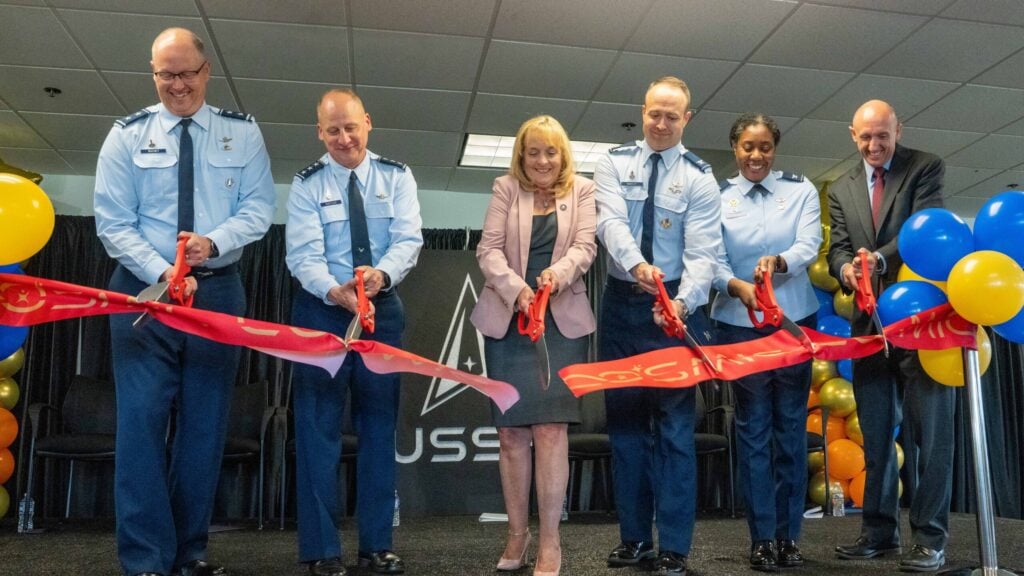
Gen. Michael Guetlein (second left), head of Space Systems Command, led the ribbon cutting June 6, 2023 for SSC’s new Commercial Space Marketplace for Innovation and Collaboration (COSMIC) center in Chantilly, VA. (US Air Force photo by Cherie Cullen.)
WASHINGTON — The Space Force’s primary acquisition command is seeking to establish a new, consolidated budget basket for commercial tech and services to underpin its multi-pronged effort to more rapidly and effectively take advantage of industry innovation, according to senior officials responsible for the effort.
“Right now, in the 2024 budget, I’m hoping to work to get [congressional] language to establish a commercial space budget line,” Col. Rich Kniseley, who heads Space Systems Command’s (SSC) recently established Commercial Space Office, said today. “So, the goal is to try and establish a 2024 line, and then work to get budget [money] hopefully in the 2025 timeframe.”
Kniseley spoke to reporters at the grand opening of the SSC’s Commercial Space Marketplace for Innovation and Collaboration (COSMIC) facility here, that will serve as his office’s “physical headquarters.” The 10,000 square-foot meeting space is designed to help SSC deepen collaboration with industry, and was stood up through a “partnership intermediary agreement” between the Basic Research Innovation and Collaboration Partnership and the Air Force Research Laboratory’s Air Force Office of Scientific Research. Support services are being provided by the Virginia Tech Applied Research Corporation “in the areas of analysis, STEM outreach, workforce development, and technology transition and transfer advisement,” according to an SSC media advisory.
“It was just really important for us to have what we’re saying is our headquarters for the Commercial Space Office out here. And it was pretty deliberately planned to have it out here in Chantilly, which is a really good sweet spot with our government partners, as well as being a good central place for industry,” Kniseley said.
In addition to the new budget line, Kniseley and others discussed new “marketplaces” and innovation labs to speed work with industry, and acknowledged a bit of a “rebranding” when it comes to the Space Force’s reach when it comes to commercial ISR.
Right Now, No ‘Dedicated’ Funding Line For Commercial
Kniseley explained that currently there is no “dedicated funding line” for SSC to use for commercial acquisition. Instead, commercial satellite communications (SATCOM) bandwidth has been bought for decades via a “working capital” fund, now totaling some $167 million, that actually goes through the Defense Information Systems Agency. That fund is expected to shift over to SSC’s control in October 2024.
Other types of capabilities are paid for by the re-obligation of unspent funds appropriated to official Defense Department “programs or record” — think money found in the back pocket of a pair of old jeans on their way to the charity bin, but millions of dollars. Up to now, SSC’s commercial acquisition outside of SATCOM has mostly been focused on space object monitoring data bought from the vetted venders making up SSC’s “space domain awareness marketplace,” Kniseley said.
Once a dedicated budget line is created and filled, he explained, “that’s going to give me a little bit more of a runway to go after a different mission areas.”
More ‘Marketplaces’ And Innovation ‘Labs’
Lt. Gen. Michael Guetlein, SSC commander, told the audience of largely industry representatives here that the ultimate goal is to look across the Space Force’s portfolio to find where the service can rapidly acquire commercial capability — rather than starting its own bespoke development programs that usually take years to result in fielded systems.
“We’re looking at weather. We’re looking at PNT [positioning, navigation and timing]. We’re looking at surveillance, reconnaissance and tracking. We’re looking at space domain awareness. That list goes on and on and on,” he said.
In fact, COSMIC will host its first reverse industry day tomorrow on “alternate” positioning, navigation and timing capabilities to back-stop in situations where GPS satellite signals are being jammed or are unavailable due to obstacles such as mountainous terrain.
One of the ways that SSC intends to expand its commercial reach is by setting up more “marketplaces” in those different mission areas, Kinseley said. Indeed, he said that a second SSC marketplace was just stood up in late May to focus on “surveillance, reconnaissance and tracking” or “SRT,” although that is “very early going” comprising only “a couple vendors.”
Finally, the beefed up Commercial Space Office — which Kniseley said will include about 10 people in the Chantilly office, as well as a redesigned, interactive “Front Door” website for engaging prospective vendors — is looking to replicate its “Tools, Applications and Processing Lab,” a digital environment that allows the Space Force to assess emerging industry capabilities for missile warning and tracking, located in Boulder, Colo.
“We’re going to stand up a similar lab in Colorado Springs for space domain awareness, and a similar lab for surveillance, reconnaissance and tracking, to expose all of that data at the unclassified level all the way to the classified level, from the raw data all the way to the processed data to our industry partners, academia, other government agencies, and even our allied partners,” Guetlein said. “And we’re going to connect it to an artificial intelligence accelerator. So, you can come into our sandbox with whatever algorithms you have to see if they add value.”
From Tac-ISR To SRT
“Surveillance, reconnaissance and tracking” is a new SSC term of art for what the Space Force has been up to now calling “tactical” intelligence, surveillance and reconnaissance (ISR) — a construct that has been a hot button issue subject to a long-running service tug of war with the Intelligence Community about roles and responsibilities for gathering ISR from satellites. “Tracking” apparently refers directly to the Space Force’s plans to acquire its own ground moving target indicator satellites, something up to now in the purview of the National Reconnaissance Office (NRO) as keeper of the nation’s various spy satellite fleets.
In particular, the Space Force and NRO for more than a year have been debating who should be buying commercial remote sensing imagery when and for what purposes, and, as Breaking Defense first reported, have been circling around a deal that would see SSC first turning to NRO to obtain commercial satellite imagery.
Asked about the language change by Breaking Defense, Kniseley admitted that it is an effort at “rebranding” to help clear up “some confusion” about the SSC’s commercial ISR acquisition plans.
“We’re working with our partners and the NRO for the commercial imagery. We’re not looking at procuring commercial imagery; we’re gonna utilize their contracts for that,” he said, noting that the office will also be “tapping into” the National Geospatial-Intelligence Agency “libraries” of remote sensing information. “So, we’re not trying to duplicate data there.”
NGA gathers the commercial imagery bought by the NRO and fuzes it into maps and other intelligence products for use across the US government, from the president down to the military commander in theater.
Kniseley said that he is instead focused on buying “platforms that synthesize raw data.”
In a Taiwan conflict, tough choices could come for Big Tech
Washington could do more to incentivize tech companies to distance themselves from China, but CEOs should examine how they’d react to a fight in the Pacific, CSET’s Sam Bresnick and Emelia Probasco argue.



























